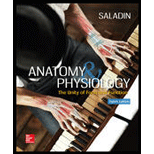
Concept explainers
Introduction:
Want to see the full answer?
Check out a sample textbook solution
Chapter 23 Solutions
Anatomy & Physiology: The Unity of Form and Function
- Can you help me to explain the name the componets of the male urinary system?arrow_forwardHypospadias is a birth defect in which the external urethral office does not appear at the tip of the penis, but somewhere on the underside of the penis. Discuss one urinary complication of having this defect and one reproductive complication of having this defect.arrow_forwardhow would a reproductive system disorder affect the urinary systemarrow_forward
- Correctly trace the movement of sperm from the testis out of the body. a. Testis – prostate – bladder – urethra b. Testis – bladder – ureter - urethra c. Testis – vas deferens – epididymis - ureter d. Testis – epididymis – vas deferens – urethraarrow_forwardThe function of the urethra is toarrow_forwardThe increased membrane fluidity has been attributed to the efflux (removal) of a single membrane lipid component. Removal of which component from the sperm’s membrane could increase fluidity without significantly altering the size and/or shape of the sperm cell?arrow_forward
- What is the structure of the lining of the urethra?arrow_forwardWhy can infection of the fallopian tubes result in infertility?arrow_forwardSildenafil citrate (marketed under the name ‘Viagra’) causes increased blood flow into the penis, thus allowing for erection to occur. Explain the mechanism by which this drug accomplishes this? What hormone is primarily responsible for the Graafian follicle rupturing to release the oocyte at ovulation?arrow_forward
- Why is oxytocin sometimes administered to a woman following parturition?arrow_forwardIf an adult male were castrated (testes were removed), what wouldhappen to the levels of GnRH, FSH, LH, and testosterone in hisblood? What effect would these hormonal changes have on his sexualcharacteristics and sexual behavior?arrow_forward
 Human Physiology: From Cells to Systems (MindTap ...BiologyISBN:9781285866932Author:Lauralee SherwoodPublisher:Cengage Learning
Human Physiology: From Cells to Systems (MindTap ...BiologyISBN:9781285866932Author:Lauralee SherwoodPublisher:Cengage Learning
